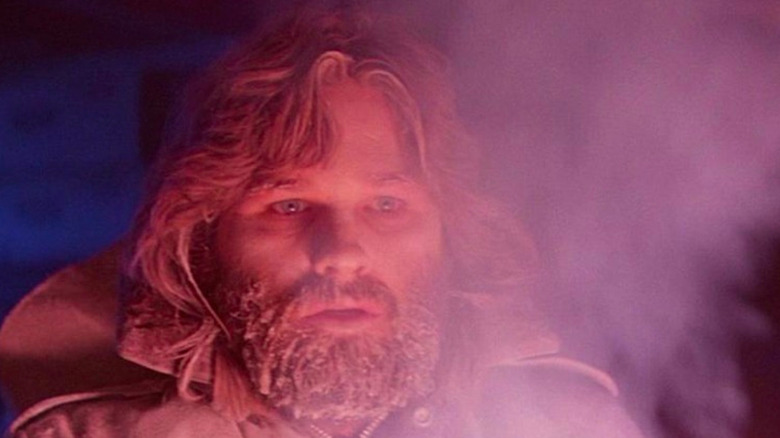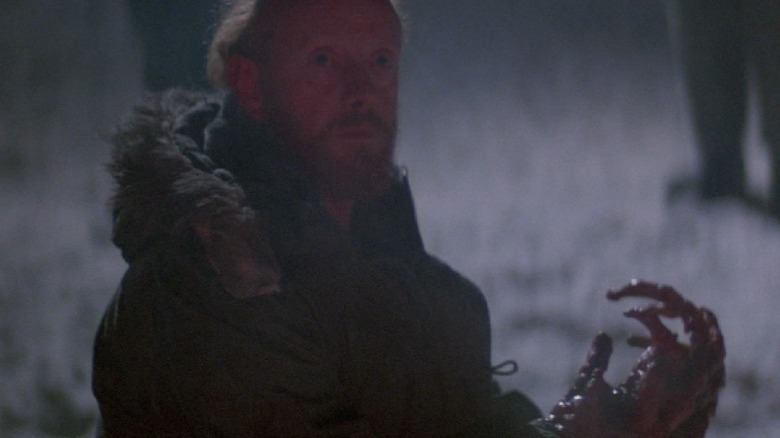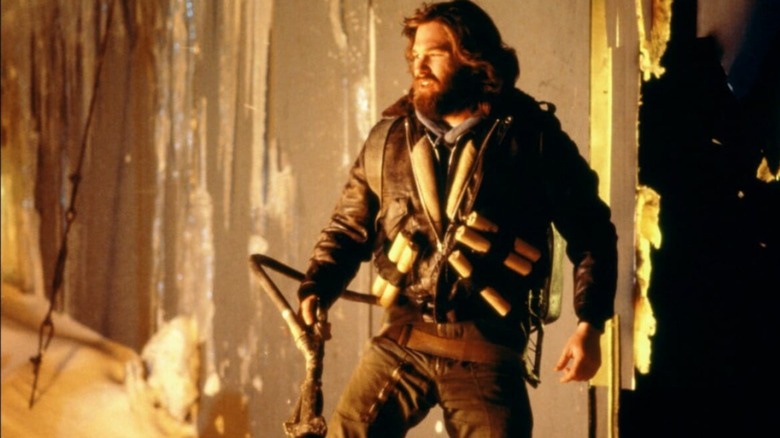Why The Thing Wasn't A Hit When It Came Out, According To Kurt Russell
When John Carpenter released "The Thing" in the summer of 1982, critics reacted to the paranoid sci-fi horror with unjustified vitriol. While it's one thing for a film to receive lukewarm reviews or completely slip under the radar, the unanimous hostility towards "The Thing" was relentless and immediate. In hindsight, this sort of reaction is baffling, given how the film is now considered a cult classic and a staple when it comes to understanding the different facets of horror in cinematic history. What was then deemed as outrageous and excessive has now undergone re-evaluation and emerged as cynical and anti-establishment — thematic threads that Carpenter explored in greater depth in his "They Live." Even from a purely technical standpoint, the practical effects in the film still manage to shock and terrify, a good case in point being the defibrillation jumpscare scene, which in my humble opinion, goes hard.
So, what went so horribly wrong when "The Thing" hit theaters in 1982? A mix of several factors could have potentially contributed to its icy reception, including unfavorable comparisons to bonafide genre hits, such as "Blade Runner" and even "Tron." Moreover, the open-ended nature of the film's ending might have added significantly to mainstream aversion to bleak nihilism — as the film deliberately avoids catharsis, character arcs, especially that of MacReady, could have been perceived as depressing or anti-climatic. In contrast, sci-fi entries that were critical darlings or commercial successes predominantly ended on a relatively positive note, while evoking emotions that were bittersweet at worst.
Kurt Russell, who played the sardonic, no-nonsense helicopter pilot MacReady, has his own conjectures as to why the cult classic was so poorly reviewed at the time, while he maintains that it is a gripping tale about paranoia masterfully handled by Carpenter. Here's what Russell had to say.
An alien who cannot be perceived
In an interview with Esquire, Russell explained that a possible reason why audiences took time to warm up to "The Thing" was that Steven Spielberg's "E.T. the Extra-Terrestrial" had been released two weeks before Carpenter's film. As opposed to Carpenter's icy foray into an alien invasion from hell, "E.T." posited a warm, cuddly rendition of extraterrestrials, while etching a story about childhood wonder, nostalgia, and found family. Moreover, while E.T. is a perceivable figure capable of compassion, the murderous, shape-shifting alien from "The Thing" cannot be seen, as it assumes the form of those we know and care about. Russell commented on this "paranoia" that the story posits and how it defied genre expectations at the time:
"It came out the same year as E.T. and we had an alien most of the audience couldn't watch! It was just a story of paranoia, extremely well handled by a master. Yet at the time, it was just 'Holy s***, what is this?' What would you call that genre? The horror genre?"
"The Thing" is a loose adaptation of John W. Campbell's novella, "Who Goes There?," which follows an Antarctic research camp that discovers and thaws the remains of an alien spaceship. While this premise forms the basis of Carpenter's adaptation, the film shifts into horror-adjacent territories, especially with the abundance of mutating flesh, anthropomorphic body parts, and the atmospheric terror that grips the narrative. Although alien invasion films preceding "The Thing" have veered into horror, the way Carpenter handles the escalating paranoia of the 'other' pretending to be someone you know/trust situates the film into a territory seldom chartered before. It is a film devoid of warmth: here, bonds dissipate under pressure, people turn on each other, and there isn't a single moment of respite.
The Thing is a sci-fi horror masterpiece
In the same interview, Russell describes the film as "a classic," remarking that it is "up there in the top echelon of horror movies." And he's absolutely right. Carpenter chooses to open his film with a memorable sequence of a dog leaping across the Antarctic, on the run from a bunch of military dudes on a helicopter hell-bent on killing the creature. Natural instincts compel us to root for the dog, who is promptly taken in by the group of researchers we will be following throughout the film. Through a series of masterful setups, both subtle and overt, Carpenter establishes the deceptive and horrifying nature of The Thing during the transformation scene. As the film progresses, the group feels increasingly on edge and distrustful of one another, which is exactly what the alien wants: to divide and conquer.
At the center of this paranoid haze is MacReady, who seems almost bored in the beginning and becomes aggressively devoted to destroying the Thing to the bitter end. Although everyone reacts negatively to his volatile cynicism, his perpetual mistrust allows them to detect the being at one point, and learn some of its behavioral patterns, which are mostly unpredictable. The creature cleverly utilizes the anticipation of betrayal and the aversion to the loss of identity in its favor, taking down men until there are only two left. Now, the Childs vs MacReady ending debate is a multifaceted one, but it highlights one essential thing: Carpenter chose to end on a note of paranoid uncertainty, a stalemate that prevents both characters (and us) from truly knowing one another.
Ambiguous ending aside, "The Thing" raises pertinent questions about individuality, autonomy, and notions of the other. It merely took the world some time to recognize the film's innate brilliance.


